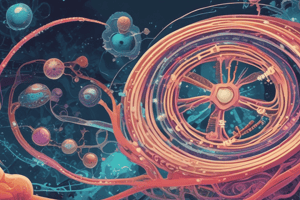Podcast
Questions and Answers
What is the primary function of dipicolinic acid in endospore formation?
What is the primary function of dipicolinic acid in endospore formation?
- To synthesize the peptidoglycan cortex
- To initiate the process of endosporulation
- To trigger the formation of the spore coat
- To stabilize the proteins and DNA in the endospore (correct)
What is the process by which a single endospore forms within a bacterium?
What is the process by which a single endospore forms within a bacterium?
- Endosporulation (correct)
- Binary fission
- Sporulation
- Vegetative cell division
What is the purpose of the cortex in the endospore?
What is the purpose of the cortex in the endospore?
- To protect the endospore from UV light and harsh chemicals (correct)
- To regulate the water content of the endospore
- To facilitate the germination of the endospore
- To provide structural support to the endospore
What is the outermost layer of the endospore?
What is the outermost layer of the endospore?
What is the final stage of endospore formation?
What is the final stage of endospore formation?
What is the result of the plasma membrane pinching off during endosporulation?
What is the result of the plasma membrane pinching off during endosporulation?
What is the primary function of ribosomes in all organisms?
What is the primary function of ribosomes in all organisms?
What is the main characteristic of endospores?
What is the main characteristic of endospores?
What is the composition of the 50S ribosomal subunit?
What is the composition of the 50S ribosomal subunit?
What is the purpose of plasmids in genetic engineering?
What is the purpose of plasmids in genetic engineering?
What is the function of inclusion granules in bacteria?
What is the function of inclusion granules in bacteria?
What is the difference between prokaryotic and eukaryotic ribosomes?
What is the difference between prokaryotic and eukaryotic ribosomes?
During protein synthesis, where does the mRNA attach to?
During protein synthesis, where does the mRNA attach to?
What is the use of Bacillus stearothermophilus spores?
What is the use of Bacillus stearothermophilus spores?
What is the composition of the cytoplasm in a prokaryotic cell?
What is the composition of the cytoplasm in a prokaryotic cell?
What is the primary function of the cytoplasm in a prokaryotic cell?
What is the primary function of the cytoplasm in a prokaryotic cell?
What is the function of mesosomes in a prokaryotic cell?
What is the function of mesosomes in a prokaryotic cell?
What is the characteristic of the nucleoid in a prokaryotic cell?
What is the characteristic of the nucleoid in a prokaryotic cell?
What is the function of plasmids in a prokaryotic cell?
What is the function of plasmids in a prokaryotic cell?
What is the characteristic of conjugative plasmids?
What is the characteristic of conjugative plasmids?
What is the advantage of plasmids that code for proteins that degrade antibiotics?
What is the advantage of plasmids that code for proteins that degrade antibiotics?
What is the size range of plasmids?
What is the size range of plasmids?
Flashcards are hidden until you start studying
Study Notes
Prokaryotic Cell Structure
- Cytoplasm:
- Composition: 80% water, nucleic acids (DNA and RNA), enzymes, amino acids, carbohydrates, lipids, inorganic ions, and low molecular weight compounds
- Function: site of most bacterial metabolism leading to growth and replication
- Mesosomes:
- Definition: Plasma membrane infoldings
- Functions:
- Role in cell wall formation
- Involved in DNA replication in prokaryotes
- Increase plasma membrane surface area and enzymatic content
- Aid in transfer of chromosomes to daughter cells
- Analogous to cristae in mitochondrial eukaryotic cells
- Nucleoid:
- Definition: Region with a single circular chromosome of double-stranded, supercoiled DNA
- Characteristics: No nuclear membrane, nucleoli, mitotic spindle, or histones
Plasmids
- Definition: Small, nonessential, extra-chromosomal DNA molecules
- Characteristics:
- Circular (linear in a few species)
- Present in cytoplasm, can be incorporated into chromosomal DNA
- Often confer protective traits, such as antibiotic resistance or toxin production
- Can be passed on through conjugation
- Replicate independently
- Functions:
- Confer antibiotic resistance
- Encode proteins for virulence factors
- Allow for horizontal gene transfer
- Useful in genetic engineering/rDNA technology
Ribosomes
- Definition: Site of protein synthesis in all organisms
- Characteristics:
- Most abundant in cytoplasm (up to 15,000)
- 70S ribosomes (50S and 30S subunits) in prokaryotes, 80S in eukaryotes
- Chemically composed of ribosomal RNA (rRNA) and protein
- Function: Workbench for protein synthesis, translating mRNA into proteins
Inclusion Granules
- Definition: Nonliving, membrane-less reserve deposits
- Examples:
- Volutin granules (inorganic phosphate)
- Polysaccharide granules (glycogen or starch)
- Lipid inclusions (e.g., PHB granules)
- Sulfur and nitrogen granules
- Gas vacuoles (buoyancy and flotation in aquatic bacteria)
Endospores
- Definition: Dormant, resistant structures produced intracellularly upon starvation
- Characteristics:
- Resistant to adverse conditions (high temperatures, irradiation, cold, organic solvents)
- Contains calcium dipicolinate
- Not a mechanism of reproduction
- Formation:
- Endosporulation process
- DNA replication, membrane wall formation, and calcium dipicolinate incorporation
- Peptidoglycan cortex, spore coat, and core wall formation
- Dehydration and maturation before release from mother cell
Studying That Suits You
Use AI to generate personalized quizzes and flashcards to suit your learning preferences.




